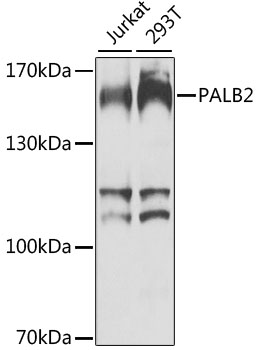Epigenetics & Nuclear Signaling Antibodies 4
Anti-PALB2 Antibody (CAB8373)
- SKU:
- CAB8373
- Product Type:
- Antibody
- Applications:
- WB
- Reactivity:
- Human
- Host Species:
- Rabbit
- Isotype:
- IgG
- Research Area:
- Epigenetics and Nuclear Signaling
Description
| Antibody Name: | Anti-PALB2 Antibody |
| Antibody SKU: | CAB8373 |
| Antibody Size: | 20uL, 50uL, 100uL |
| Application: | WB |
| Reactivity: | Human |
| Host Species: | Rabbit |
| Immunogen: | Recombinant fusion protein containing a sequence corresponding to amino acids 99-198 of human PALB2 (NP_078951.2). |
| Application: | WB |
| Recommended Dilution: | WB 1:500 - 1:2000 |
| Reactivity: | Human |
| Positive Samples: | Jurkat, 293T |
| Immunogen: | Recombinant fusion protein containing a sequence corresponding to amino acids 99-198 of human PALB2 (NP_078951.2). |
| Purification Method: | Affinity purification |
| Storage Buffer: | Store at -20'C. Avoid freeze / thaw cycles. Buffer: PBS with 0.02% sodium azide, 50% glycerol, pH7.3. |
| Isotype: | IgG |
| Sequence: | TLDV GPES FNPG DGPG GLPI QRTD DTQE HFPH RVSD PSGE QKQK LPSR RKKQ QKRT FISQ ERDC VFGT DSLR LSGK RLKE QEEI SSKN PARS PVTE IRTH |
| Gene ID: | 79728 |
| Uniprot: | Q86YC2 |
| Cellular Location: | Nucleus |
| Calculated MW: | 131kDa |
| Observed MW: | 150kDa |
| Synonyms: | PALB2, FANCN, PNCA3 |
| Background: | This gene encodes a protein that may function in tumor suppression. This protein binds to and colocalizes with the breast cancer 2 early onset protein (BRCA2) in nuclear foci and likely permits the stable intranuclear localization and accumulation of BRCA2. |
| UniProt Protein Function: | PALB2: Plays a critical role in homologous recombination repair (HRR) through its ability to recruit BRCA2 and RAD51 to DNA breaks. Serves as the molecular scaffold in the formation of the BRCA1-PALB2-BRCA2 complex which is essential for homologous recombination. Strongly stimulates the DNA strand-invasion activity of RAD51, stabilizes the nucleoprotein filament against a disruptive BRC3-BRC4 polypeptide and helps RAD51 to overcome the suppressive effect of replication protein A (RPA). Functionally cooperates with RAD51AP1 in promoting of D-loop formation by RAD51. Essential partner of BRCA2 that promotes the localization and stability of BRCA2. Also enables its recombinational repair and checkpoint functions of BRCA2. May act by promoting stable association of BRCA2 with nuclear structures, allowing BRCA2 to escape the effects of proteasome-mediated degradation. Binds DNA with high affinity for D loop, which comprises single-stranded, double-stranded and branched DNA structures. Defects in PALB2 are a cause of susceptibility to breast cancer (BC). A common malignancy originating from breast epithelial tissue. Breast neoplasms can be distinguished by their histologic pattern. Invasive ductal carcinoma is by far the most common type. Breast cancer is etiologically and genetically heterogeneous. Important genetic factors have been indicated by familial occurrence and bilateral involvement. Mutations at more than one locus can be involved in different families or even in the same case. Breast cancer susceptibility is strongly associated with PALB2 truncating mutations. Conversely, rare missense mutations do not strongly influence breast cancer risk (PubMed:22241545). Defects in PALB2 are the cause of Fanconi anemia complementation group N (FANCN). It is a disorder affecting all bone marrow elements and resulting in anemia, leukopenia and thrombopenia. It is associated with cardiac, renal and limb malformations, dermal pigmentary changes, and a predisposition to the development of malignancies. At the cellular level it is associated with hypersensitivity to DNA-damaging agents, chromosomal instability (increased chromosome breakage) and defective DNA repair. Defects in PALB2 are the cause of pancreatic cancer type 3 (PNCA3). It is a malignant neoplasm of the pancreas. Tumors can arise from both the exocrine and endocrine portions of the pancreas, but 95% of them develop from the exocrine portion, including the ductal epithelium, acinar cells, connective tissue, and lymphatic tissue. |
| UniProt Protein Details: | Protein type:Tumor suppressor Chromosomal Location of Human Ortholog: 16p12.2 Cellular Component: nucleoplasm Molecular Function:DNA binding; protein binding Biological Process: DNA synthesis during DNA repair; double-strand break repair via homologous recombination; strand displacement Disease: Breast Cancer; Fanconi Anemia, Complementation Group N; Pancreatic Cancer, Susceptibility To, 3; Tracheoesophageal Fistula With Or Without Esophageal Atresia |
| NCBI Summary: | This gene encodes a protein that may function in tumor suppression. This protein binds to and colocalizes with the breast cancer 2 early onset protein (BRCA2) in nuclear foci and likely permits the stable intranuclear localization and accumulation of BRCA2. [provided by RefSeq, Jul 2008] |
| UniProt Code: | Q86YC2 |
| NCBI GenInfo Identifier: | 74727919 |
| NCBI Gene ID: | 79728 |
| NCBI Accession: | Q86YC2.1 |
| UniProt Secondary Accession: | Q86YC2,Q8N7Y6, Q8ND31, Q9H6W1, A6NIE1, |
| UniProt Related Accession: | Q86YC2 |
| Molecular Weight: | 131,295 Da |
| NCBI Full Name: | Partner and localizer of BRCA2 |
| NCBI Synonym Full Names: | partner and localizer of BRCA2 |
| NCBI Official Symbol: | PALB2 |
| NCBI Official Synonym Symbols: | FANCN; PNCA3 |
| NCBI Protein Information: | partner and localizer of BRCA2 |
| UniProt Protein Name: | Partner and localizer of BRCA2 |
| Protein Family: | Partner and localizer of BRCA2 |
| UniProt Gene Name: | PALB2 |
| UniProt Entry Name: | PALB2_HUMAN |
View AllClose







